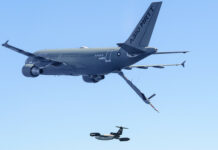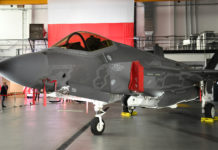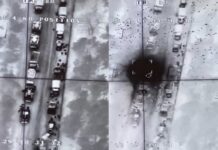Swarms of unmanned vehicles represent a disruptive evolutionary phase of unmanned warfare. In this article, we regard swarms as groups of Unmanned Vehicle Systems (UXS) operating autonomously in a coordinated manner to carry out a mission. The UXS elements may be aerial, land-based, surface, or undersea robotic platforms carrying out tasks ranging from:
- Intelligence, Surveillance, and Reconnaissance (ISR)
- Target Acquisition and Attack
- Suppression and Destruction of Enemy Air Defense (SEAD/DEAD)
- interdiction of high priority targets such as command posts, communications equipment, and radars
At sea, swarms of small boats or loitering weapons and unmanned submersible vehicles can be used to disable enemy vessels by taking out their vulnerable assets such as radar and communications or sonar. Swarms can also be used preemptively to suppress enemy activity in specific areas such as airfields, landing zones, or launching sites of ballistic missiles.
Unlike attacks by individual drones or loitering weapons that require a human controller in the loop, drone warms receive the brief and pursue the mission autonomously, constantly coordinating their behavior based on the mission phase to achieve their goal most efficiently. For example, they can plan and maneuver to attack the target from different directions, strike multiple targets at once, or sacrifice some elements in the swarm to trigger the target to react and reveal itself before being hit. Human controllers are primarily in a supervising role and would intervene and instruct the drones only when needed or asked for by the swarm.
Benefits of a Swarm
Drones acting in groups can be controlled individually by human controllers or operate fully autonomously as a group. Other operating methods follow herding behavior, in which some members serve as leaders while others act as followers. UXS swarms are often controlled from a single multi-launcher and ground control station, thus simplifying and accelerating deployment. Once launched, the individual drone’s operation is mainly autonomous, enabling a single operator to manage the whole swarm instead of flying each drone.
Swarms may include many elements of the same platform (known as homogeneous swarms) or different players forming a heterogeneous group. Each drone may perform a similar role or have several specialised functions, such as information gathering, weapons deployment, or communications relaying. The key to their behavior is the network connecting all members. Typically, such a network enables the group to link all members by constantly retransmitting information, position, and navigation. Specific group members may assume control of the entire formation at different times to coordinate and prioritize actions, assign tasks, alert on obstacles or threats, or hand over power to other members. If a control node is eliminated, other members will take control based on the network’s self-forming, self-healing algorithms.
Most commercial remote-controlled drones are controlled via frequency hopping spread spectrum (FHSS), using an advanced frequency-agile waveform, or by Wireless LAN (WLAN). Signals transmitted from the drone also use FHSS, wideband, or WLAN signals. Other drones may rely on Radio Frequency (RF), cellular or satellite communications (SATCOM). Swarms often utilise ad-hoc networking technologies (MESH network) to communicate between the group members. This method is specifically advantageous when operating beyond visual line of sight and over broad areas where existing connectivity is not guaranteed. Individual drones may connect to and disconnect from the network all the time, making the decentralised ad-hoc network structure highly suitable for their operation.
Countering the Swarm
Despite their autonomous operation, drones and robots require comprehensive preparations before being sent into the mission. Route planning, pre-flight network setup, GNSS link establishment, coordination with controller and other group members are all done before takeoff to initiate an autonomous mission. Most of this activity has a distinctive electronic signature that can be detected by signals intelligence (SIGINT) activity. But some preparations are less visible than others. For example, loitering drones packed ready to launch on their carriers often perform this preparation in radio silence, without any emissions, testing, and setup are performed on the carrier.
Once the swarm is launched and grouped, its members can maneuver into formations, making individual target detection more difficult. Navigation to the target could employ global navigation satellites (GNSS, GPS), inertial navigation, image-based scene matching, or a combination of several methods, making it more challenging to defeat. Group members can rely on each other to determine their position and location, thus maintaining sensor redundancy to overcome specific countermeasures such as GPS jamming.
Unlike unitary autonomous drones that can be completely isolated on their mission, a swarm has a significant vulnerability – the network it depends on. Swarm members must communicate continuously to share information, status, and tasks. Since these networks use specific waveforms, their activity could be detected by SIGINT to provide the first alert of swarm activity in the area. Therefore, SIGINT is considered the first line of defence against swarms, used as a part of a whole layered defense system.
Attack the Network
As the network signals are picked and tracked, and network vulnerability is assessed by SIGINT, the defender may decide to use electronic or cyber-attack against the threat. Given the extended range of such detection, relying on strategic airborne or space-based SIGINT assets, the defender can avoid surprises by preparing and executing a game plan against that threat. Detection and tracking of the individual swarm members pose another significant challenge since radar, and electro-optical sensors are limited in their ability to detect small, slow, and low-flying targets, particularly at long range. Detection of targets moving underwater is almost impossible. Moreover, detection of such targets on the move is limited due to the noise and clutter the sensors encounter.
C-UAS detection and countermeasures systems such as the ARDRONIS developed by Rohde and Schwarz (R&S) target the drone’s RF signal activity using sensitive monitoring receivers to collect and disrupt the drone controls. According to R&S, the sensor can detect a DJI Phantom 4 mini drone from up to 5 km. When engaging drones using FHSS, ARDRONIS compares the detected signals with an extensive library of drone profiles. This “monitor and match” process provides reliable early warning of any threats in the coverage area. The system also provides direction finding (DF) of the drone telemetry, video downlink, and the control unit, indicating the operator’s location. The system also has an integrated jammer that disrupts the targeted drones or the communications between the drone and the controller, with minimum disturbance to other signals in the same frequency band.
Rohde & Schwarz and OpenWorks have teamed to establish an autonomous 3D detection and tracking system in counter unmanned aerial systems (C-UAS) missions. The system has been integrated through NATO’s new “plug and play” protocol known as ‘Sensing for Asset Protection with Integrated Electronic Networked Technology’ (SAPIENT) and tested at the NATO Technical Interoperability Exercise (TIE) event in De Peel Airbase in the Netherlands. The ARDRONIS drone detection solution combined with OpenWorks’ SkyAI Autonomous Optical technology and integrated with command and control systems and decision engines to match escalating UAS threats. ARDRONIS provides a primary detection capability to locate unmanned aircraft and remote controllers using a spectrum analysis approach. SkyAI takes this 2D data and combines it with information received from remote sensors through the SAPIENT network. It then takes control of the EO/IR camera associated with the system to search for UAS autonomously. Using real-time advanced AI target classification, the EO/IR sensor locks the target and streams high-quality video to the system operator for further threat analysis. The data from SkyAI ARDRONIS sensors is then fused to provide a full 3D location of the UAS being tracked.
Understanding the Situational Picture
Drone Guard from IAI represents another multi-layered solution for detecting and interception of drones and drone swarms. It consists of several passive and active sensor types that are integrated with soft and hard kill effectors through a unified C2 system. The detection and classification layer relies on a multi-mission 3D X-band AESA radar and SIGINT system that detects and exploits UAS data link communication for threat detection and classification. A day/night EO/IR sensor supports target classification and acquisition. Drone Guard uses various means of interception that include jamming or takeover as soft-kill measures and hard-kill measures such as precision rifle scope, rockets, or a drone-kill-drone (DKD) solution.
The system’s core is the command and control element that collects data from the sensors, automatically correlates the information, defines priorities and creates a unified situational awareness picture that enables the timely deployment of countermeasures against the threats. The system consistently learns and adapts to new threat types through Machine Learning (ML) and is equipped with built-in, advanced decision-making and Artificial Intelligence (AI) algorithms for threat analysis and manual, semi-autonomous, or fully autonomous response.
Drone Dome from Rafael is another ‘end-to-end’ C-UAS solution having the counter-swarm capability that integrates various sensors in a multi-layered architecture. The system employs RADA’s RPS-82 radar in a static or vehicular configuration, using four AESA radar panels to cover 360 degrees. In addition to target detection and tracking, the RPS-82 employs micro-doppler algorithms for target classification. The SIGINT element covers 70 MHz up to 6 GHz spectrum to localize the drone’s position and its operator and process Difference Time of Arrival (DTOA) of detected signals to enhance situational awareness. Another automation layer is the systems’ EO/IR sensors that support video motion detection (VMD), enabling automatic detection, recognition, and tracking of multiple targets based on drone patterns libraries.
The system generates a comprehensive map-based situational picture allowing a single operator to conduct scalable threat mitigation, employing Reactive Jamming (RJ) and GNSS countermeasures up to the use of high high-power laser, which has already demonstrated the engagement of swarm formations, defeating multiple drones in quick succession.
Awareness: The Key for Survival
Therefore, situational understanding is key to defeating the swarm as far and early as possible by targeting the networking mesh that turns it from a group of drones to an advanced and almost indestructible machine. Fusing many sensors and information sources into a Situational Awareness (SA) picture enables the defenders to act most efficiently, aiming at the swarm’s weaknesses. Depending on the operating strategy, these could be the datalinks, the network itself, or the herders leading the group. Actions could employ soft kill such as offensive cyber, electronic combat (jamming, GPS denial). Kinetic measures range from deploying nylon streamers and fragments clogging the drone’s propellers and rotors to directed energy effects of a high-power microwave or high-energy lasers, airburst munitions, and firearms autonomously commanded and controlled by the C-UAS system.
One of the most sophisticated command and control systems developed for C-UAS is the LATTICE from Anduril. The system creates a shared understanding of the battlespace in real-time by autonomously parsing data from thousands of sensors and data sources and transforming it into an intelligent common operating picture. Using sensor fusion, computer vision, edge computing, machine learning, and artificial intelligence, Lattice detects, tracks, and classifies every object of interest in an operator’s vicinity. This ambitious system scales the SA from the tactical level to the strategic view. Anduril aims to deploy LATTICE across land, sea, air, and space as an all-domain mission engine. It employs its mesh network to ensure information flow even in remote and contested areas, enabling resilient information flow and cooperative teaming even when there is limited bandwidth.
Defeating the Drones
Other C-UAS systems such as D-Fend’s EnforceAir and DroneShield’s DroneSentry-X support tactical units to protect:
- VIPs
- special forces
- dismounted teams
- individual vehicles
- convoys
EnforceAir automatically identifies rough drones in the vicinity and then automatically takes control of them using cyberattacks and lands them in a safe, designated area. According to D-Fend, this mitigation method employs target-specific protocols without causing interference to friendly communications or authorized drones’ operations. The system can be used as a man-portable tactical kit or on a vehicular mount to support static or mobile operation, creating a moving ‘bubble’ of protection.
During the detection and identification phase, the system remains passive to enable covert forces to maintain radio silence. Since the drones are forced to land near the defended unit, military intelligence can exploit the captured drone data to learn which type of drones are used, where they are sent from and what their cameras are recording. Drone takeover takes only a few seconds, enabling the system to engage small groups effectively.
DroneSentry-X is a different mobile C-UAS system as its defeat capabilities rely on jamming and do not involve protocol manipulation or ‘cyber’ tactics. The system can be operated in stand-alone mode and integrates sensors and a mitigator to disrupt UAS operations in its vicinity and protect the platform over 360 degrees.
Swarm Information
Both DroneShield and D-Fend employ ‘surgical’ actions against single or small groups of drones to bring them down before they reach their objectives. Other means using Electro-Magnetic Pulse (EMP) and High-Power Microwave (HPM) emitters use much more powerful and less selective means to eradicate all electronic systems and activity in the area. This action can take down many drones at once but also damage other systems that were not protected against such ‘electronic shock treatment.’ Several systems of this type have already appeared in the market, indicating the technology has matured to be integrated into UAV and C-UAV systems.
Such weapons are designed as ‘sacrificial’, meaning they are destroyed during the activation or ‘reusable’. Engineers at the Naval Surface Warfare Center have conceptualised an explosively formed electromagnetic pulse that could be packed as a warhead inside missiles or drones, becoming a weapon that would enable an interception and defeat of UAVs. The EMP device, known as a ‘flux compression generator’, is constructed of a coil woven into an air-tight cylinder. The cylinder is filled with ionized lithium gas that establishes a strong magnetic field during activation. The cylinder is compressed by an explosive charge, accelerating the ionised gas molecules through an increased magnetic field that generates a powerful electromagnetic burst in the terawatt regime. The spherical EMP destroys the interceptor UAV and disables any electronic systems in its vicinity.
Reusable high-power electromagnetic effectors employ microwave emitters of different designs to deliver energy bursts that can disable electronic circuits from a distance. Initially, these were large, truck-sized systems that required powerful generators and cooling to produce the desired effect. Most land-based systems were directional, while the more compact systems covered a spherical pattern based on the explosive-generated power burst. Recent advancements in high-power solid-state HPM have matured new HPM effectors more suitable for tactical use.
LEONIDAS
One of these is the LEONIDAS, based on the SmartPower technology developed by Epirus Inc. It uses solid-state amplifiers to transmit directed energy at extremely high-power causing counter-electronics effects. Epirus utilises artificial intelligence-enabled Gallium Nitride (GaN) semiconductors arrays to produce the extreme power density levels necessary for the HPM transmission without special cooling. The frequency-agile system rapidly fires a barrage of unique waveforms to exploit the specific frequencies that UAS targets are most susceptible to. This enables tactically relevant counter-swarm ranges beyond small arms fire, even against diverse swarms.
A full-size ground-based ‘LEONIDAS’ effector uses very high energy to deliver the effect from a distance, while a smaller version packed in a pod can be carried by a drone closer to the target. Since the system uses electrical power, Leonidas has deep magazines to enable continuous rapid firing for precision or area fires effects without overheating or reloading.
This technology has already been integrated with some of the air defense capabilities of the US Army. In 2020 Northrop Grumman Corporation announced a strategic supplier agreement with Epirus to offer Leonidas as a component of its Counter-Unmanned Aerial System (C-UAS) systems-of-systems solution offering. Northrop Grumman’s C-UAS solutions already deliver a layered architecture with a full complement of kinetic and non-kinetic effects, aerial and ground sensors of the Forward Area Air Defense Command and Control (FAAD-C2) system selected by the US Army as the interim C2 system for counter-small-UAS capabilities. The agreement augments the systems’ non-kinetic capacities to defeat UAS swarms. In another agreement, Epirus announced in late 2021 the company has teamed with General Dynamics to integrate Leonidas on the Army’s IM-SHORAD systems that already provide C-UAS protection on the move to combat elements, enabling the Army to engage drone swarms.
Drones Vs Drone Swarms
LEONIDAS has also been shrunk to fit a small pod carried by a drone. The pod integrates with existing airborne systems to go where end-users want it to go, flying directly to the threat area. When deployed with ground-based LEONIDAS units, both systems work in unison to achieve greater power and range and create a layered defense forcefield.
Other C-UAS systems operating HPM include the MORFIUS C-UAS drone from Lockheed Martin. The company used the Altius 600 drone from Dynetics’ Area-I company, packed with Lockheed Martin’s HPM effector, MORFIUS, to engage drone swarms at range and speed. The tube-launched drone carries an HPM effector payload and a seeker, enabling it to home in on the target from a long distance. Both are recoverable and reusable. The tube-launched drone platform can be deployed from air, ground, or vehicle on the move, supporting a layered defense approach.
Raytheon has recently demonstrated a similar concept with its COYOTE Block 3 turbine-powered C-UAS missile. In this demonstration, the COYOTE took down a group of 10 drones using an unspecified non-kinetic effector. The targets group included drones that differed in size, complexity, maneuverability, and range. The test also proved the Coyote could be recovered and redeployed after the engagement. COYOTE also has been demonstrated to deploy from vehicles, aircraft, helicopters, and drones.
High Power Lasers
High power lasers also provide an effective counter-swarm capability for their ability to rapidly defeat small and maneuvering targets by destroying the drone’s airframe, energy source, optics, or electronic circuits. The ability to “fire” multiple shots in quick succession at low cost makes lasers suitable for Very Short-Range Air Defense (VSHORAD)missions and countering small swarms of several drones. Such lasers are already being integrated with some C-UAS platforms, such as the Stryker DE M-SHORAD, Raytheon’s HELWS2, and Rafael’s Laser Drone Dome laser effector that have already demonstrated the capability to defeat small groups of drones. Both lasers and HPM effectors offer a low-cost-per-shot option to operators, requiring only electrical energy for operation. However, lasers are limited by weather, as they cannot penetrate thick clouds, while HPM can cause collateral damage in its area.
Summary
Swarms of autonomous, AI-powered, and networked drones are becoming a disrupting military capability in their ability to carry out missions far beyond the size and capabilities of a single drone. There is no silver bullet to defeat a swarm, as countermeasures require a system of systems at least as advanced, sophisticated, and evolving as the drones themselves, leveraging some of the technologies employed by drones.












